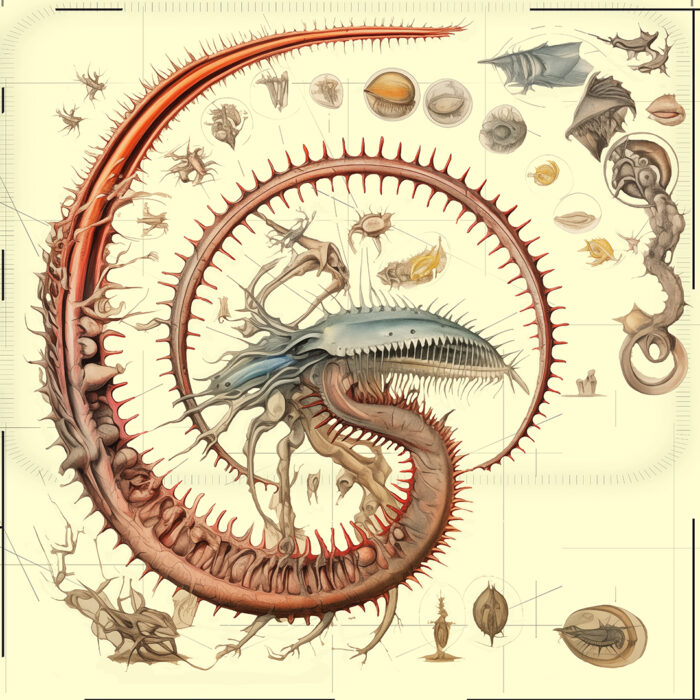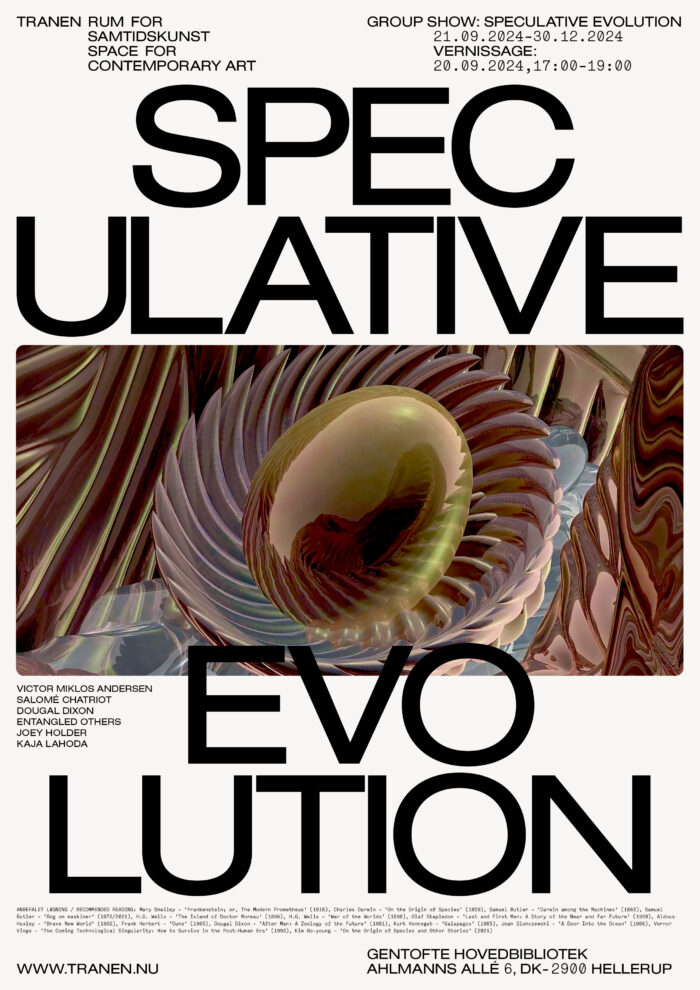Victor Miklos Andersen, Salomé Chatriot, Dougal Dixon, Entangled Others, Joey Holder, Kaja Lahoda
Speculative Evolution
21.09.2024–30.12.2024
VERNISSAGE :
20.09.2024,17:00–19:00
Gruppeudstillingen Speculative Evolution præsenterer seks kunstnere, hvis værker er repræsentative for en global tendens inden for samtidens kunst og kultur. Værkerne viser stigende interesse for udviklingen af livet på jorden i alle afskygninger – fra planter og dyr over mennesker til kunstige livsformer. Tendensen ses i lyset af den hastige udvikling af jordens klima og biodiversitet samt videnskab og teknologi, der tvinger os til at genoverveje, hvor vi kommer fra og er på vej hen.
Tanker om, at det mangfoldige liv på jorden har udviklet sig over tid, spores tilbage til det antikke Grækenland. Men først med On the Origin of Species fra 1859 begyndte den kristne forestilling om de gudgivne arters uforanderlighed at vakle. Som den første præsenterede Charles Darwin en evolutionsteori, der endte med at skabe konsensus blandt fagmænd og hinsides. Hypoteser og bevisførelse forankrede spekulationer i ny empirisk videnskab. Teorien viste sig både at være så overbevisende og mangelfuld, at den nye videnskab paradosalt inspirerede nye og endnu vildere spekulationer. Og Darwins teoris forklaringskraft fandt hurtig anvendelse inden for andre vidensområder.
Allerede i 1863 publicerede en af Darwins disciple, Samuel Butler, overvejelser om maskinernes evolution. I fremtiden så han ”det maskinelle rige” underlægge sig menneskene. Hans vilde ideer er i dag virkelige bekymringer. I den aktuelle debat om kunstig intelligens hører man teknologiudviklere og forskere foreslå udviklingen sat på pause og forslag om indføring af obligatorisk ”kill switch” eller stopknap.
I starten af det 20. århundrede inspirerede både Darwin og hans satiriske discipel Butler flere science fiction forfattere. H.G. Wells skrev om hybrider af mennesker og dyr, Aldous Huxley fremstillede et ”fagert voksent” verdenssamfund af genetisk modificerede mennesker og Olaf Stapledon projicerede menneskeheden 2 milliarder år ind i fremtiden.
Imens science fiction blev stadig mere anerkendt som seriøs litterur og kultur, begyndte eksempler på stadig mere litterær og kunstnerisk videnskab at se dagens lys. I 1980’erne udgav geolog og palæontolog Dougal Dixon en international bestsellertrilogi om hele økosystemer i alternative evolutionære fortider og zoologiske, posthumane fremtider. Fra og med udgivelsen af After Man fra 1981 etableredes Dixon som ophavsmand til en ny bølge af spekulativ evolution i gråzonen mellem kunst og videnskab. Dixons alternative evolutionære fortællinger beroede ikke blot på det skrevne ord, men også videnskabelige illustrationer og animation. I dag er Dixon også en forløber blandt samtidskunstnere, hvoraf denne udstilling præsenterer fem.
Dougal Dixon holder åbningstalen.
Udstillingen er støttet af Ny Carlsbergfondet.
Anbefalet læsning / Recommended reading:
Forfatter / Author
Titel / Title
Udgivelsesår / Publication date
Mary Shelley
Frankenstein; or, The Modern Prometheus
1818
Charles Darwin
On the Origin of Species
1859
Samuel Butler
Darwin among the Machines
1863
Jules Verne
Twenty Thousand Leagues Under the Seas
1870
Samuel Butler
Erewhon
1872
H.G. Wells
The Island of Doctor Moreau
1896
H.G. Wells
War of the Worlds
1898
Arthur Conan Doyle
The Lost World
1912
Olaf Stapledon
Last and First Men: A Story of the Near and Far Future
1930
Aldous Huxley
Brave New World
1932
Frank Herbert
Dune
1965
Dougal Dixon
After Man: A Zoology of the Future
1981
Kurt Vonnegut,
Galapagos
1985
Joan Slonczewski
A Door Into the Ocean
1986
Vernor Vinge
The Coming Technological Singularity: How to Survive in the Post-Human Era
1993
Kim Bo-young
On the Origin of Species and Other Stories
2021

